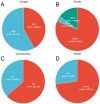Direct anastomosis indwelling needle puncture: a rapid and safe transitional hemodialysis access for patients with renal failure
- PMID: 39828900
- PMCID: PMC11749010
- DOI: 10.1080/0886022X.2024.2448255
Direct anastomosis indwelling needle puncture: a rapid and safe transitional hemodialysis access for patients with renal failure
Abstract
Objectives: Vascular access thrombosis (VAT) is a common complication in patients with end-stage renal disease (ESRD), significantly impacting hemodialysis efficacy and patient survival. Currently, temporary dialysis access is typically established via deep vein catheterization (VC), however, this method is highly invasive and associated with risks of infection and other complications. This study aims to explore the feasibility of using direct anastomosis indwelling needle puncture (DAINP) for temporary dialysis access.
Methods: Between March 2023 and March 2024, patients VAT were recruited at Sir Run Run Shaw Hospital of Zhejiang University School of Medicine to undergo DAINP. Clinical data, including age, gender, dry and wet body weight, and blood biochemical parameters, were collected. Patient VA types, locations, and insertion vessels were documented. Detailed assessments and records of VAT were performed for all patients, including the distance of thrombus from the anastomosis, residual blood flow at the VA anastomosis, and corresponding selection of the DAINP insertion site. Ultrasound was utilized to measure and record the puncture depth. Concurrently, clinical data of patients undergoing venous catheterization (VC) for temporary dialysis access were collected. The operative time for both groups, defined as the interval from ultrasound assessment initiation to completion of the procedure, was recorded and compared.
Results: A total of 74 patients successfully underwent DAINP, with a 100% puncture success rate. Among them, 20 patients had residual blood flow at the VA stump, and the distance between the anastomosis and arterial flow was ≥ 1 cm. Patients with VA located at the elbow demonstrated the greatest puncture depth. Moreover, the operative time for the DAINP group was significantly shorter compared to the 17 patients who underwent VC for VAT during the same period. However, patients with VA located in the groin required a longer operative time for DAINP.
Conclusions: This study demonstrates that DAINP provides a rapid and safe method for establishing temporary hemodialysis access in VAT patients, effectively reducing the invasiveness and risks associated with traditional VC.
Keywords: End-stage kidney disease; hemodialysis; indwelling needle; thrombosis; vascular access.
Conflict of interest statement
No potential conflict of interest was reported by the authors.
Figures





Similar articles
-
Complications of the vascular access for hemodialysis.Contrib Nephrol. 2004;142:193-215. doi: 10.1159/000074862. Contrib Nephrol. 2004. PMID: 14719394 Review. No abstract available.
-
Right atrial bypass grafting for central venous obstruction associated with dialysis access: another treatment option.J Vasc Surg. 1999 Mar;29(3):472-8. doi: 10.1016/s0741-5214(99)70275-2. J Vasc Surg. 1999. PMID: 10069911
-
The endless history of vascular access: a surgeon's perspective.J Vasc Access. 2006 Jul-Sep;7(3):103-11. doi: 10.1177/112972980600700303. J Vasc Access. 2006. PMID: 17019661 Review.
-
Hemodialysis access in the pediatric patient population.Am J Surg. 1994 Aug;168(2):197-201. doi: 10.1016/s0002-9610(94)80067-7. Am J Surg. 1994. PMID: 8053526
-
Approach to vascular access for hemodialysis: experiences from the Republic of Macedonia.Int J Artif Organs. 2002 May;25(5):354-64. doi: 10.1177/039139880202500503. Int J Artif Organs. 2002. PMID: 12074331
References
-
- Rohmah SN, Puspitasari M, Prasanto H, et al. . Effect of intradialytic aerobic exercise intervention on dialysis adequacy and quality of life in patients with end-stage kidney disease undergoing hemodialysis at Dr. Sardjito General Hospital, Indonesia. Int Urol Nephrol. 2024;56(11):3595–3604. doi: 10.1007/s11255-024-04100-x. - DOI - PubMed
MeSH terms
LinkOut - more resources
Full Text Sources
Other Literature Sources
Medical
